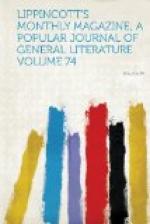Surprised by a midnight storm, the camp was broken up before the early daylight, and our explorers’ caravan moved on without breakfast. This necessary stop-gap was arranged for at the first pleasant spot on the route. An old clearing soon appeared, provided with the welcome accommodation of an ajoupa, or shed built upon four posts. At the command of Alto alli!—“Halt there!”—uttered by Perez in the tone he had formerly used in governing his troops, the whole band stopped as one person; the porters dumped their bales with a significant ugh! the Bolivian bark-hunters laid down their axes; and the gentlemen arranged themselves around the parallelogram of the hut, attending the commissariat developments of Colonel Perez. The site which hazard had so conveniently offered was named Chaupichaca. It was the scene of an ancient wood-cutting, around which the trunks of the antique forests showed themselves in a warm soft light, like the columns of a temple or the shafts of a mosque.
A detail which struck the travelers in arriving was very characteristic of these lands, filled so full of old traditions and inca customs. Chaupichaca was marked with a square terminal pillar, one of those boundaries of mud and stones, called apachectas, which Peruvian masonry lavishes over the country of Manco Capac. A rude cross of sticks surmounted this stone altar, on which some pious hand had laid a nosegay, now dried—signifying, in the language of flowers proper to masons and stone-cutters, that the work was finished and left. A little water and spirits spared from the travelers’ meal gave a slight air of restoration to these mysterious offerings, and a couple of splendid butterflies, whether attracted by the flowers or the alcoholic perfume, commenced to waltz around the bouquet; but the corollas contained no honey for their diminutive trunks, and after a slight examination they danced contemptuously away.




